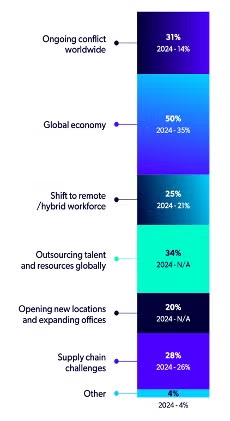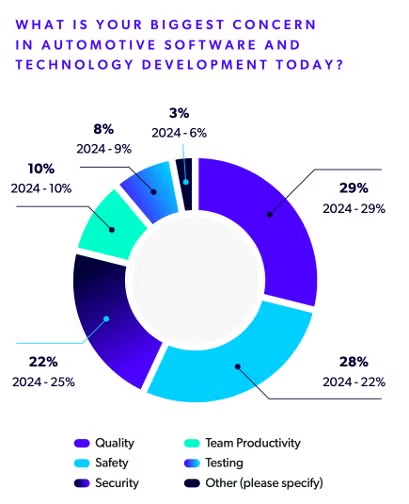The automotive industry has been undergoing significant changes as it works to adapt to growing market demands and challenges associated with electric, autonomous, and hybrid vehicles.
Here, we take a look at some notable automotive trends 2025 that were highlighted in our report, 2025 State of Automotive Software Development, in partnership with Auto IQ and the Eclipse Foundation.
We received survey responses from over 650 automotive software professionals from OEMs and Tier 1-3 suppliers, working all over the world in a variety of positions from developers to managers to compliance officers.
In this blog, we highlight some of the major insights and themes from the report that reflect the current state and future direction of automotive software development.
Read along or jump ahead to the section that interests you the most:
Table of Contents
- Automotive Trends 2025: Top Market Conditions and Strategies
- AI Is Driving Vehicle Development and Design
- Software Quality and Safety Are the Leading Concerns for Automotive Software Development 2025
- Coding Standards Are Key to Keeping Pace with Automotive Industry Trends 2025
- Learn More About Emerging 2024 Automotive Software Development Trends
➡️ Download the 2025 Automotive Software Report
Back to topAutomotive Trends 2025: Top Market Conditions and Strategies
The global economy was a leading market condition that has most impacted automotive organizations this year, making industry competitiveness a key focus area for 58% of automotive professionals in 2025.

Source: 2025 State of Automotive Software Development Report
How organizations plan to maintain industry competitiveness varied by professional role in the organization. Directors and managers, for example, were more interested in competitiveness overall, while engineers and developers prioritized maximizing existing resources. Functional safety/security officers and compliance officers were most interested in educating existing talent, addressing gaps in experience levels and coding compliance knowledge.
For instance, one of the biggest challenges in automotive software security was meeting regulations requiring cybersecurity approval, but fortunately, teams are addressing this concern: 76% of survey respondents said that their organization offers security training for developers, an increase of 12% over last year.
To maximize existing resources across teams and save time during development, most automotive developer respondents understand the importance of shifting to the left of the SDLC, and are using coding standards and guidelines such as MISRA®. In addition, tools such as static code analyzers, version control or data management, and project management tools are used heavily among automotive software developers.
AI Is Driving Vehicle Development and Design
The introduction of AI in vehicle design is making a noticeable impact on automotive software development, particularly in autonomous vehicle production.
Around 80% of automotive organizations are using AI for at least some autonomous and connected vehicle components. While fully autonomous vehicles are still not ready for the road full-time, including AI in the vehicle design process and including AI during operation may accelerate the advance of autonomous vehicles.
There are plenty of concerns around AI, though. The leading concern was safety, namely “safe decision-making for AI algorithms in autonomous/semi-autonomous vehicles.” Security and avoiding vulnerabilities was the second most-concerning issue.
Fortunately, new regulations and standards are being developed with AI in mind. ISO/DPAS 8800, for example, was recently introduced to provide guidance on the safe integration of AI into autonomous vehicles.
Back to topSoftware Quality and Safety Are the Leading Concerns for Automotive Software Development 2025
It used to be the case that all you had to do was look under the hood to have a working understanding of how a car worked. However, it’s no longer that simple. Modern vehicles feature a great deal of software to enhance user experience as well as provide drivers with safety and convenience features. All this software must be designed with both safety and security in mind — and that depends on the quality of the code and adherence to coding standards.
This year, quality continued to lead as the top concern in automotive software and technology development for 29% of respondents, with safety following close behind for 28% of respondents and security for 22%. Team productivity and testing were of less concern, but did see some changes that align with the 2025 themes — for example, many teams are struggling to meet the performance and scalability demands of a global workforce.

Source: 2025 State of Automotive Software Development Report
Back to topCoding Standards Are Key to Keeping Pace with Automotive Industry Trends 2025
An essential part of the automotive software development process is ensuring that the software is compliant with key industry standards and guidelines.
In 2025, 86% of automotive development organizations now use at least one coding standard. Coding standards are important for code quality, which ensures the code is safe, secure, and compliant.
The most popular coding standard continues to be MISRA® at 53%, which is expected to increase this year due to the recent release of MISRA C:2025.
Compliance with the functional safety standard ISO 26262 is required for more survey respondents than ever before this year: 83% of automotive professionals said they need to comply, either for a market, customer, or internal requirement.
More automotive organizations must achieve the Automotive Safety Integrity Level (ASIL) level D than other levels. ASIL D is the maximum level of risk.
📕 Related Resource: "How to Comply with the ISO 26262 Standard"
The leading challenge this year in proving compliance was the difficulty fulfilling every safety requirement and providing the necessary evidence that all the compliance requirements had been met.
One of the most efficient methods to enforce and verify compliance with functional standards is to use a static analysis tool.
Back to topLearn More About Emerging 2024 Automotive Software Development Trends
As more hardware components are replaced with software, it is essential that automotive software is not only safe but secure as well. By reviewing industry research, you are able to not only keep pace with the challenges of this year but also for the years to come.
Download your free copy of the 2025 State of Automotive Software Development Report, which contains over 60 pages of analysis, infographics, and information on leading challenges, best practices, and emerging trends.
